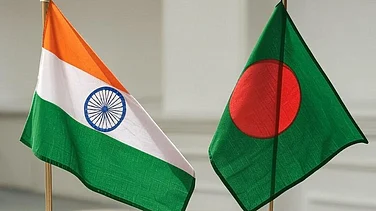In the past two months, the scenes of flattened neighbourhoods in the Gaza Strip and waves of Palestinians leaving their homes have come to symbolise the long-running Israel-Palestine crisis in public imagination.
In the worst fighting in decades in Gaza, around 1.9 million Palestinians have been displaced internally, according to the United Nations (UN).
This is not, however, the first time the Palestinians have faced displacement. Displacement has been a running theme in the Israeli-Palestinian conflict as Palestinians have often been displaced as territories changed hands, such as in the wars in 1948 and 1967. To a lesser extent, Israelis have also been displaced through the many wars and conflicts, but they don't face the statelessness that the Palestinians do.
As the Israeli military and Hamas battle it out in Gaza, we explore the cycle of displacement of the Palestinians and the wars and conflict that fuelled the displacement.
The Nakba Of 1948
Nakba means catastrophe in Arabic. It refers to the displacement of around 700,000 Arabs, who identified as Palestinians, after the 1948 Arab-Israel War.
It was the first major round of displacement of the Arabs. Today, there are around 5.9 million Arabs displaced throughout the Middle East who say the root of their displacement is in the Nakba, according to the figures from the United Nations (UN). The UN Relief and Works Agency for Palestine Refugees in the Near East (UNRWA) says that nearly a third of them live in 18 townships it runs throughout the Middle East in Jordan, Lebanon, Syria, Gaza, and West Bank.
The displacement occurred over the months of the Arab-Israel War. In 1947, the UN in its partition plan gave around 56 per cent of the land to Israel, half of which was the Negev desert, and the rest 43 per cent to the Arabs. The Holy Land of Jerusalem including the neighbouring Bethlehem was to be with an international administration. While the Jews agreed to the plan, the Arabs rejected it and Egypt, Iraq, Syria, Lebanon, Saudi Arabia, and Transjordan (present-day Jordan) invaded Israel as they rejected the notion of the Jewish state. The Arab countries lost. By the end of the war, the Jews who were assigned 56 per cent of the land for the State of Israel ended up with around 77 per cent of the total area. Around 700,000 Arabs were displaced because of the war.
While the fighting and the unfavourable result of the war were the major factors, the promise of the Arab leaders that they would beat the Jews in war and would reinstate the Arabs in the region later was also a factor for displacement.
Later, the UN acknowledged the Right to Return of the displaced Arabs. While the proposed return has not happened, further displacement has happened over the years and disagreement over the extent of the return has often been an irritant in Israeli-Arab peace talks. While 700,000 Arabs were displaced in 1948, the number today is around 5.9 million and there exist fundamental questions about their return, the nature of their return, and their status in any future Palestinian state.
The Arab Displacement In 1967 War
The 1967 Arab-Israel War resulted in an Israeli victory and the further expansion of Israeli territories and the displacement of Palestinians. The Arabs refer to the episode as 'Naksa', which means a setback or defeat in Arabic.
In 1967, based on intelligence reports, Israel realised they were facing another Arab offensive from the neighbours. Anticipating the offensive, Israel pre-empted the war and scored a stunning victory and occupied the Sinai Peninsula, West Bank, Gaza, East Jerusalem, and Golan Heights. Several of those displaced in the war were those who were also displaced in the 1948 war, making it the second such experience in two decades. Many fled to Egypt and Syria. The total number of displaced was around 300,000.
"More than a third of those Palestinians displaced in 1967 were already refugees from 1948 and thus suffered a second forced migration. Just as in 1948, when the 1967 war ended, the Israeli government blocked the return of any refugees and proceeded to destroy several Palestinian villages in the occupied territory, including Emmaus, Yula and Beit Yuba. After their destruction, these areas were leased to Jewish Israelis," notes Michael Vicente Perez, Associate Professor of Anthropology, University of Memphis, in an article for The Conversation.
Displacement From Regional Conflicts
While the major rounds of displacement happened in the Arab-Israel Wars of 1948 and 1967, regional conflicts have also caused such displacement of Arabs.
The primary three regional conflicts that forced Palestinians out were the Jordan-Palestine War, the Iraq-Kuwait War, and the ongoing Syrian Civil War.
Jordanian-Palestinian Conflict
Jordan has a very unique position in the entire conflict as it houses a very large Palestinian diaspora as well as a refugee population. It is ruled by a royal family that claims direct descent from Islam's founder Prophet Muhammad through his daughter Fatima and her husband Ali-bin-Abi Talib, who was also the fourth Islamic Caliph. The King of Jordan is also the custodian of the Islamic holy sites in Jerusalem, a city sacred to the three Abrahamic faiths of Judaism, Christianity, and Islam.
Following the 1967 debacle, the Palestine Liberation Organisation (PLO), which was at the time waging a full-blown armed movement against Israel instead of peaceful negotiations, had also become active in Jordan against the government and the royal family. The PLO led by Yasser Arafat was creating troubles in East Jordan where the government's grip also came in question. Arafat was training an army to attack Israel in Jordan. An even more radical Palestinian group called Popular Front for the Liberation of Palestine (PFLP) hijacked four passenger planes and blew up three of them, following which the then-King of Jordan, Hussein, declared martial law and thus began the Jordan-PLO War.
"On September 17 a deeply frustrated King Hussein responded by ordering his 50,000-strong army to kick the Palestinian fighters out of the Hashemite kingdom. Tank divisions, their faces blackened with soot, pushed into the centre of Amman, refugee camps on the outskirts of the capital and Palestinian training centres. The next day clashes extended to Irbid, Zarka and al-Ramtha in northern Jordan, which were pounded with heavy artillery by Jordanian troops," notes AFP in an article.
While ceasefire was soon reached and thousands of Palestinians, including fighters, were evicted from the country, Arafat remained in Jordan and fresh fighting erupted in 1971 and Arafat and the remaining Palestinian armed elements were driven out to Lebanon.
The 1970 war came to be known as 'Black September'. The PLO puts the death toll of the conflict in tens of thousands.
Iraq-Kuwait Conflict
The Iraq-Kuwait War, also called the Gulf War, of 1990-91 led to the expulsion of around 3-400,000 Palestinians living in Kuwait. The expulsion was fuelled by Kuwait's belief that the Palestinians supported the invading Iraqis in the war.
In 2004, Palestinian Authority (PA) President Mahmoud Abbas, who continues to rule PA without elections since then, apologised for the Palestinian stand towards Kuwait in the war. It was seen as an effort to make peace with Kuwait, which was once the main backer of PLO but drove it out after the war with Iraq in which it suspected the Palestinians were on the other side.
Several thousands of Palestinians evicted from Kuwait arrived in Jordan, which is one of the main places of refuge for them since 1948.
"The 250,000 Palestinians here in Jordan, a nation of about three million, are being joined by others at the rate of 34,000 a month. About 80 percent of the refugees live in Amman, with most of the rest in Zarqa," noted an article in The New York Times in 1991.
Syrian-Civil War
Hundreds of thousands of Palestinians in townships across the country have been displaced in the decade-long Syrian Civil War.
The military of Syrian dictator Bahar al-Asad has been accused of attacking Palestinian townships along with other Syrians he perceived to be opposed to his regime. During 2011-20, at least 3,196 Palestinians were killed and around 400,000 were displaced, according to the Syrian Network for Human Rights (SNHR). Of the displaced, around 280,000 have been displaced internally in Syria and around 120,000 were forced to flee to neighbouring countries, as per SNHR.
The SNHR credits the displacement to the following reasons: Syrian regime’s arrests, torture, bombardment, siege, and destruction of most Palestinian townships from indiscriminate shelling. The SNHR says such attacks took place in Al Yarmouk, Daraa, Handarat, and Khan al Sheeh.


























